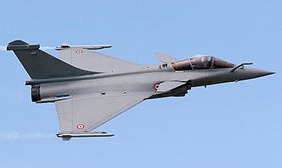IAF in final negotiations of $20-bn Rafale deal
17 Jul 2014
The deal to acquire 127 Rafale fighter planes for the Indian Air Force from French manufacturer Dassault Aviation, held up by the previous government for lack of funds, is gathering pace under the new Bharatiya Janata Party-led administration.
 Officials of Dassault, Hindustan Aeronautics Ltd (HAL), and the IAF will engage in 48 hours of negotiations in Bangalore over the deal to acquire the fighter jets under the long-delayed Medium Multi Role Combat Aircraft (MMRCA) contract.
Officials of Dassault, Hindustan Aeronautics Ltd (HAL), and the IAF will engage in 48 hours of negotiations in Bangalore over the deal to acquire the fighter jets under the long-delayed Medium Multi Role Combat Aircraft (MMRCA) contract.
Reports today suggested the conclusion of this round of talks will probably be decisive.
The IAF may complete its work before December this year, following which the matter will be placed before the Cabinet Committee on Security (CCS. The deal will probably be finalised before the end of this financial year.
The IAF's plans to have 42 squadrons by 2022 have been hit by the phasing out of the ageing and crash-prone Russian MiG fighters and delay in fresh acquisitions. The almost antiquated MiG21 meanwhile remains a mainstay of its forces.
And of course, the state-controlled HAL has miserably misspent its considerable funding - the indigenous Light Combat Aircraft (LCA) Tejas, originally conceived as a replacement for the ageing MiGs, is yet to take off.
The Indian Air Force is reported to have withstood a high-pressures and aggressive campaign by the British and American defence manufacturers to junk the Rafle deal in favour of their own aircraft.
The induction of the Rafale fighter jets will give IAF the much needed teeth to undertake multiple missions, including long-range air strikes, facilitated by powerful radar jammers that are part of the plane's electronic warfare suite.
For IAF, which has long been confined to using Russian fighter jets that use Soviet era technology, Rafale is the better option because it is a safer twin-engine aircraft.
The French have proposed to supply a modified version of the Rafale suitable for delivering atomic weapons, opening up the possibility of its role in imparting ''second strike'' capability, which is central for validating India's posture of credible nuclear deterrence.
The Rafale aircraft will supplement IAF's current agile fleet of Russia-made Su-30 MKIs, which form the core of the IAF's strike force and the older strike force that include French Mirage-2000 jets and the Jaguar bombers.
For military transport, IAF has acquired some the heavy lift four-engine ''super'' Hercules C-130j from US aircraft manufacturer Lockheed Martin, besides a helicopter fleet of Russia-made Mi-17s that outclass most of their competitors.
The IAF has been looking for an aircraft that would help it establish air dominance with the capability to aggressively monitor and destroy emerging threats, quickly establish freedom of manoeuvre in hostile airspace and undertake punishing deep strikes on high value targets, in order to undermine the adversary's potential.
The life cycle costs have also been a major factor in persuading the IAF to go in for the Rafale. IAF wants to fly the new aircraft for the next 40 years by which time the domestic military industry is expected to supplement its requirements.
''When issues of maintenance, including fuel consumption and structural reliability in its entire life cycle were taken into account, it was found that the Rafale was cheaper in comparison to its competitors from Russia and Britain,'' reports quoted sources as saying.
The Su-30 MKI that forms the core of the IAF's strike force outclass most of its competitors in the field of aerodynamics, but since modern air combat is conducted at long ranges, this is hardly relevant.
High maintenance costs, resulting, for instance, from fuel guzzling engines, deficiencies in avionics and shortfalls in the durability of airframes, are persuading the IAF to look for alternatives.
IAF is also switching to French A330 MRTT refuelling planes from its current batch of Russia-made IL-78 air-to-air refuellers, which are central for extending the strike range of fighter aircraft.
Russians, however, have entered into a partnership with Indian companies for weapons development to compensate the loss of turf. The two countries are also partnering to develop fifth generation fighter jets.













.jpg)






.jpg)









